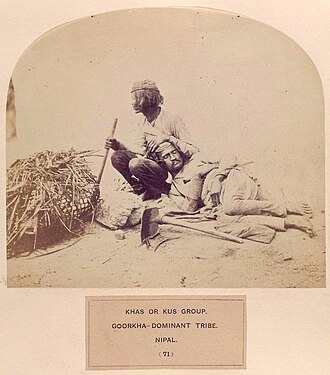Khas (original) (raw)
De Wikipedia, la enciclopedia libre
 |
El texto que sigue es una traducción defectuosa. Si quieres colaborar con Wikipedia, busca el artículo original y mejora esta traducción.Copia y pega el siguiente código en la página de discusión del autor de este artículo: {{subst:Aviso mal traducido|Khas}} ~~~~ |
|---|
| Khas/Parbattiya/Pahari खस/पर्वत्या/पहाडी | |
|---|---|
| Idioma | Idioma nepalí previamente Idioma Khas |
| Religión |  Hinduismo Hinduismo |
| Etnias relacionadas | Other Indo-Aryan peoples |
| [editar datos en Wikidata] |
Khas man of Nepal, as depicted in The People of India (1868-1875)
La gente de Khas (en nepalí: खस) es un grupo etno-lingüístico indo-ario que habla Khas (nepalí), actualmente idioma de Nepal, y Kumaon y Garhwal de India. También eran conocidos como 'Parbattias' y 'Paharis'. El término Khas ha quedado obsoleto.
Han sido relacionados con Khasas, mencionados en la antigua literatura hindú, así como con el reino Khas Malla medieval.[1] Tradicionalmente, la gente Khas se dividía en Khas Brahmins y Khas Kshatriya (también llamado Khas Rajputs). Debido al poder político del reino de Khas Malla, la gente de Khas tenía un alto estatus social.[2]
Copper Inscription by King of Doti, Raika Mandhata Shahi at Saka Era 1612 (शाके १६१२) (or 1747 Bikram Samvat) in language of Khas Kingdom, the old Khas Idioma
Hasta el siglo XIX, los Gorkhalis se referían a su país como Khas Desh (País de Khas).[3] El Código de Conducta Legal de 1854 ya no se refería a Khas como nación, en lugar de jat (o comunidad) en el Reino Gorkha.[4]

Khas people of Nepal, as depicted in The People of India (1868-1875)
Khas women, photographed in 1880- [
 ](/wiki/Archivo:Major%5FIndo-Aryan%5Flanguages.png "Khas language, shown as a Northern Indo-Aryan language "Nepali" (in purple color)")
](/wiki/Archivo:Major%5FIndo-Aryan%5Flanguages.png "Khas language, shown as a Northern Indo-Aryan language "Nepali" (in purple color)")
Khas language, shown as a Northern Indo-Aryan language "Nepali" (in purple color)
Actualmente, la gente de Khas se refiere como a si misma como Khas Bahun y Khas Chhetri (también Khas Rajput).[2] En la región de Kumaon de la India, la gente de Khas adoptó la designación de Kumaoni Jimdar Rajput.[5]

Procession of Nepali Hindu Wedding; groom wears Dhaka dress used only by Khas Parbattia community
Senior offering Dashain Tika; a feature of Khas Parbattia community
Jhakri, a shamanistic practice evident in modern Khas people in Darjeeling, India
- ↑ John T Hitchcock, 1978, pp. 112-119.
- ↑ a b John T Hitchcock, 1978, pp. 116-119.
- ↑ Richard Burghart, 1984, p. 107.
- ↑ Richard Burghart, 1984, p. 117.
- ↑ K. S. Singh, 2005, p. 851.
- Dor Bahadur Bista (1991). Fatalism and Development: Nepal's Struggle for Modernization. Orient Blackswan. ISBN 978-81-250-0188-1.
- John T Hitchcock (1978). «An Additional Perspective on the Nepali Caste System». En James F. Fisher, ed. Himalayan Anthropology: The Indo-Tibetan Interface. Walter de Gruyter. ISBN 978-90-279-7700-7.
- K. S. Singh (2005). People of India: Uttar Pradesh. Anthropological Survey of India. ISBN 978-81-7304-114-3.
- Richard Burghart (1984). «The Formation of the Concept of Nation-State in Nepal». The Journal of Asian Studies 44 (1): 101-125.
- Susan Thieme (2006). Social Networks and Migration: Far West Nepalese Labour Migrants in Delhi. LIT Verlag Münster. ISBN 978-3-8258-9246-3.
- William Brook Northey; C. J. Morris (1928). The Gurkhas: Their Manners, Customs, and Country. Asian Educational Services. ISBN 978-81-206-1577-9.

